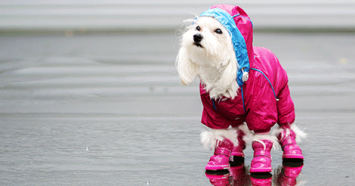
It’s not uncommon to see dogs wearing boots when there is snow on the ground and ice on the sidewalks, but there are many other times and places where boots can save his paws from harm. Two years ago, a friend and I took our dogs (my two English Shepherds and her Jack Russell Terrier and Poodle mix) camping in Arizona. We weren’t in the lower desert with cactus, we were in the upper desert. Higher elevations but still dry.
Apparently (and unknown to us when we arrived) the area was home to a weed that produced burrs with long sturdy thorns. Ouch! The thorns were so long they would go completely through the sole of flip flops. The first step caused the dogs to lift paws and shake. Thankfully, we carry dog boots in our camping gear and the dogs wore them the entire week we were camping.
Dog boots can protect your dog’s paws from snow, ice, ice treatments, burrs, thorns, and all kinds of other things than can cause harm to your dog’s paws. They can also increase traction when walking, climbing, and wading across streams while you are camping and hiking. Luckily, when properly fitted and introduced to your dog, very few dogs protest wearing them once they get over the initial introduction.
Proper Sizing
There are several different types and brands of dog boots and the easiest way to take a look at them is to do an online search for ‘dog boots.’ Some are light-weight, more like socks, while others have a thicker, rubber sole much like our shoes. Take a look at several and see which ones might work best for your dog in the situations where he might need to wear them.
Sizing will vary according to the type of boot and the brand, but each of the brand websites include sizing instructions. For example, my dogs wear the Ruff Wear Grip Trex boots. To size them, I needed to measure the width of my dogs’ paws. But, here’s a hint: Don’t hold your dog’s paw in your hand and measure it. Instead put the ruler on the floor and have your dog stand on it, with his weight on his paw. Just as with us, the foot spreads slightly when supporting the dog’s weight.
Ideally, the boot should fit the paw closely but not tight. If it’s too loose or too tight, it will rub and cause blisters or sores. If you have questions about the right size or fit, or if you think your dog has a uniquely shaped paw, call and talk to the company.
Introducing the Boots
If you search for dog’s new boots on social media, you’ll see a wide variety of canine reactions to wearing new boots. Most dogs lift a paw high, shake it vigorously, and high step like a prancing horse. Although the videos are funny we can do better when introducing boots.
First, have a good soft treat your dog likes. Peanut butter, cream cheese, or cheese in a can all work. A soft treat works better than crunchy treats because it takes the dog longer to swallow it.
With your dog on leash and close to you, give him a lick of the soft treat so he knows what the pay off is. Then let him sniff the dog boot and give him another lick of the treat. Do this a couple times so he thinks the dog boot equals cream cheese!
With your dog sitting or lying down, put one boot on one front paw and give him another lick of the treat. Don’t let him go dashing off wildly as he’ll just focus on getting the boot off. Keep him close and put a boot on the other front paw. Now, with both front paws wearing boots, invite him to stand and immediately offer a few licks of his treat. Remember, you want him to think dog boots equal cream cheese.
Then, with him on leash and you showing him his special treat, invite him to walk a few steps. Reward often and interrupt him should he try and tear the boots off his feet. After just a few minutes, praise him lavishly and take the boots off. Once the boots are off, don’t offer any more lavish praise or special treats. Those are for when the boots are on. Just be casual, “Good boy!”
After a few training sessions, when your dog walks nicely with just the front boots on, repeat the training sessions for the back boots.
Short Walks at First
Once your dog is walking around the house with all four boots on, take him on a couple of short walks outside. Keep the walks short, both time and distance-wise, as you’ll need to keep checking his paws for rubbing or sores as he gets used to wearing them.
You may need to adjust the tightness of the fastenings or even try different sized boots. Sizing dog boots is much like choosing shoes for us; some shoes, styles, or brands work better than other others. If your dog is sore, though, call the company and explain what’s going on. I’ve found customer service to be quite helpful.
When he’s comfortable and his boots fit well, gradually take him for longer walks on different surfaces. He’ll need to get used to them to prevent slipping or falling.